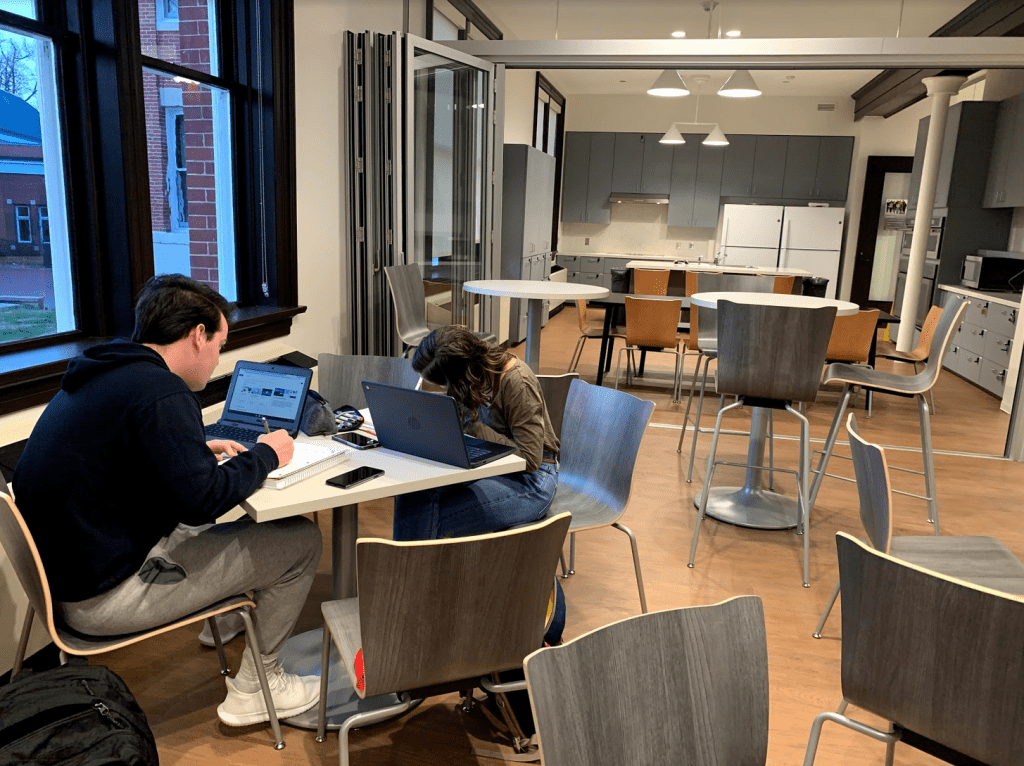Grand reopening of Willard includes newly renovated common spaces
4 min read
Plans for next semester include hosting FSEM classes in the Willard seminar rooms. (Abigail Buchholz | The Blue & Gray Press)
by BERNADETTE D’AURIA
Staff Writer
Virginia Hall residents moved out of their dorm rooms and into the newly renovated Willard Hall on Jan. 8. David Fleming, the assistant dean for Residence Life and Housing, said the move went better than he anticipated.
“We contracted with Apple Transfer, which is a moving company that we use for a lot of different things on campus,” said Fleming. “I think [students and parents] were stressed out very early and not sure what was gonna happen, but we got a lot of positive feedback.”
Students who used the moving company’s services returned to campus from winter break several days early. Those who did not want to move in early had to move their belongings from Virginia to Willard on their own.
Most students were placed with the same resident assistants and kept the same roommate. Fleming believes that the few students who will have a different RA or a new roommate will not feel isolated by the new environment.
“Regardless of whether they’re moving to a different building or not, our RAs should be resetting at the beginning of the year… everyone in our communities around campus has new members and so any time that even one person leaves or enters a community it changes the dynamic,” said Fleming.
Current Willard resident and freshman Eugene Hlaing believes that the community is tighter than ever and that the move has brought people together. He said this is due in part to the layout of the new building, which includes a parlor on the first floor.
“Considering how large and open the common room is, maybe I just notice it more,” said Hlaing.
Rather than hanging out in their rooms, Hlaing has noticed many residents congregating together in the common room. “People are pretty happy with it because there are going to be times where you don’t want to be in your room but you also don’t want to be in the great outside world.”
According to Hlaing, one downside of the open space on the first floor is that it distorts the typical sense of ownership students have over their own space.
“The first floor is so open that you constantly feel like ‘this isn’t a place I live, this is a place I kind of inhabit,’”said Hlaing.
In the original plans, the first floor of Willard was going to be an area on campus that everyone had access to. Residents of Willard were going to have access to their rooms through an additional card swipe, while other students would be able to enter the common room on the first floor.
“Based on some code issues that Richmond gave us we weren’t able to set that up exactly the way we wanted to,” said Fleming. With the need for safe emergency exits and the concern over who would be getting in and out of the building, the open floor idea was abandoned for the time being.
Despite this, there are plans to hold classes in the Willard seminar room. Fleming hopes the room will be used by Willard freshman next semester taking their FSEM. However, commuters and part time students will still need to get into the building for those classes. Fleming stated that anyone who has a class in that seminar room would have access to the building.
Now that the Virginia Hall residents are occupying Willard Hall, construction on Virginia Hall will begin as soon as possible.
“I think submittals are out now for demolition so we’re waiting on bids right now. We anticipate demolition beginning in March and once demolition is complete, which usually takes a couple months, they will move into constructing… Fencing should start to go up at the end of this month,” said Fleming.
Unlike the construction on Willard Hall, the renovations on Virginia will attempt to preserve the interior and the historic architecture that defines the building. In the late 1970s, Willard Hall went through a renovation that covered up much of the historical aspects of the building. Therefore, much of the recent renovations involved undoing the work which covered up the original design. The material from Willard that wasn’t able to be salvaged got a modern update.
“Pretty much the whole building needs renovation,” said Martha Garcia-Ferrufino, a former Virginia Hall resident and senior business administration major. Garcia-Ferrufino said that with the renovation, she feels that Virginia’s character should be maintained. “I think they could clean and polish it up,” she says.











